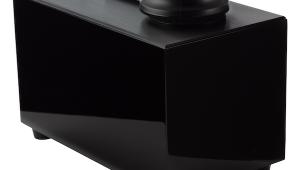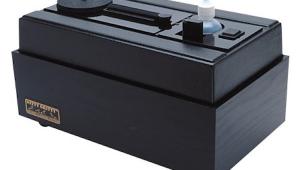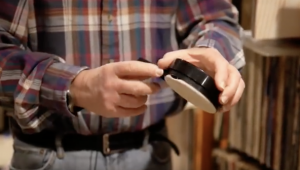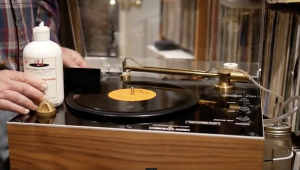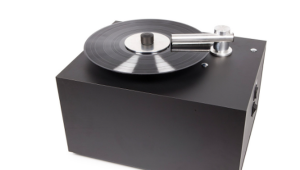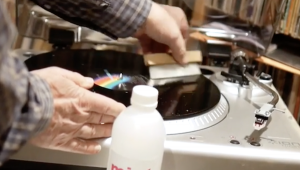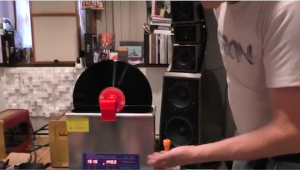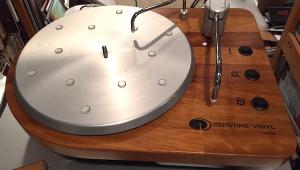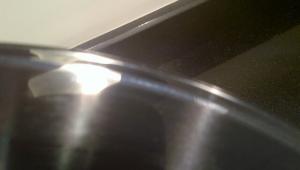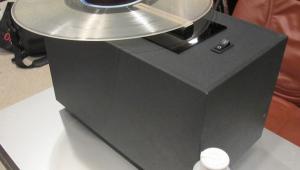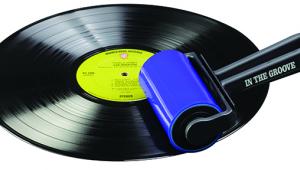Surely the good folks at CleanerVinyl can suppply a sample!!??
CleanerVinyl Is a Less Costly Ultrasonic Record Cleaning Alternative
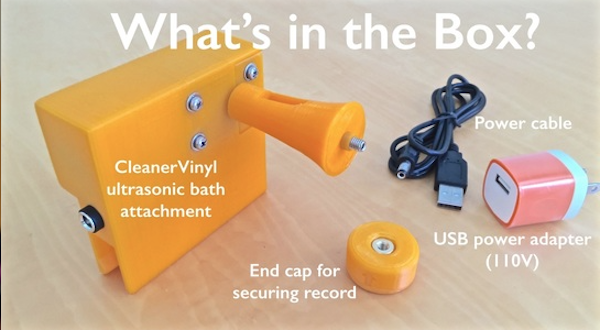
In this business model, you are responsible for buying the ultrasonic bath (about $150 online) and then CleanerVinyl does the rest, offering you various options or they will "bundle" the ultrasonic bath with its "Cleaner Vinyl One", which consists of a powered 3D printed attachment to which you secure a record that's lowered into the water.
The CleanerVinyl One costs $189 or for $349 the company will ship to you the CleanerVinyl One plus an ultrasonic bath. It's probably worth giving the company the $10 difference. The separate option is more for international customers, the company says.
For an additional $25 you can add the CleanerVinyl Two, that allows simultaneous cleaning of two records. Or instead, buy the CleanerVinyl Pro for $379 that allows you to simultaneously clean up to twelve records. Of course you still have to add the ultrasonic bath.
The company also makes available for $129 the CleanerVinyl Dry that turns the bath into a drying rack. This requires you to first drain the fluid using the included drain tube and then to install the fan.
So the process would be to first put the record (one, two or twelve) in the vat, and let it spin for around fifteen minutes (of course with the cavitation turned on), then drain the liquid via the tube, and then attach the fan and continue spinning for approximately forty five more minutes (more or less depending upon humidity and temperature).
The result is a twelve at a time ultrasonic washing and drying system costing $658 or a single record at a time system costing as little as $350.
How well does it work? I don't have an ultrasonic bath and I'm not investing $150 in order to review CleanerVinyl but I thought you'd like to know about it.
- Log in or register to post comments



Personally, I would spend the extra money on the VinylStack. The CleanerVinyl look Mickey Mouse. It looks like it was printed on a hobby level 3D printer.

Yes, the CleanerVinyl One is made using custom designed 3D printed parts. But, hey, it is 2016!!...;-). That is why it fits the ultrasonic cleaner perfectly. Consider the CleanerVinyl Pro version if you need higher throughput (up to 12 records in one run) and the CleanerVinyl Dry accessory for accelerated drying times. Nothing Mickey Mouse here! Designed and made in the US with quality mechanical and electrical parts! One year warranty. Visit www.cleanervinyl.com for more info and demo videos.

I have had the VinylStack for a few months. It's a little pricey given the individual parts used, and feels slightly homebrew, but it saved me having to fabricate the same thing on my own. It's sturdy, and it works reliably.
I bought one of those less expensive chinese-import ultrasonic baths and it's a bit flaky. But even despite that, with this ultrasonic cleaning process followed by a clear water rinse-and-vac on a record vacuum, I have never had cleaner sounding records. I have a newer VinylStack that holds only three LPs but I have to say, that is just enough for me to keep up with in terms of cleaning speed. I will be upping my game with a better ultrasonic and more powerful record vac in the near future.
FWIW, Harry Weisfeld uses this same method--he has a VinylStack, an ultrasonic bath, and the Typhoon (or Cyclone, or whatever it's called) VPI vac, and has done his own listening tests and determined it's one of the best methods he has used for cleaning records.

I have been using the VinylStack with my own ultrasonic bath for over a year. The albums then get a distilled water vac on my VPI 16.5. Outstanding results! There is no reason to spend $4,000 when you can build one of these for about $500. I highly recommend this method. I've cleaned albums that I always thought had pressing defects because they never came clean with other cleaning products. Those same albums have come completely clean and sound amazing.

... generating all that micro-level turbulence anywhere near the grooves of my records... if there is any dirt/dust (and that's the point of cleaning, if the records are not clean) it will basically work as an abrasive agent to the much softer vinyl surface. Would love to see a study of this under the microscope (must be a really huge amplification), before and after Ultrasonic cleaning of a used record with normal dirt/dust on it, to confirm how it impacts the plastic and the sharpness of the grooves. I've read some users discussing loss of high frequency energy because of this... knowing how this works, seems perfectly reasonable to me. Besides... it's a lot of work, much more than a regular vacuum RCM with stellar results :)

Actually ultrasonic cleaning is a lot more "stellar" than RCM. You do not lose any high frequencies with ultrasonic cleaning. There is no findings for this. These statements have been made by neurotic audiophiles! The Japanese have been cleaning records this way for years. There is no damage to the groove walls. I for one only hear amazing results with this cleaning process. So much better than RCM. I know because I have used some very amazing cleaning fluids with RCM, but ultrasonic cleaning will get rid of particles in the grooves that were still trapped after RCM cleaning. It's also a lot simpler and easier than some 4 step cleaning processes that are out there.Take the plunge, you will be very surprised what your albums can sound like!

We at CleanerVinyl could not agree more. All your tests yielded that there is no perceivable damage to vinyl records, even after extended (several hours) ultrasonic runs. This is not surprising since ultrasonic cleaning is a well established (over several decades) cleaning method in research and development, as well as for many industrial processes where damage to the cleaned surface must be minimized. In fact, anything that touches the surface mechanically like a brush or a sponge pad will cause abrasion. Not so with ultrasonic waves. They are much more gentle to intricate objects like record grooves. Another advantage of ultrasonic cavitation is that the microscopically cleaning steam bubbles are forming in all locations where the fluid penetrates. Brushes etc... cannot get all the way down into the grooves. A word about vacuum based methods: They work well for removing loose dust particles, but 'caked on' contamination such as cigarette soot or mineral deposits cannot be removed with a vacuum system.

I had a Nitty Gritty 1.5FI and cleaned a couple of thousand records that I loved.Had to sell it about 10 years ago as well as my system.
Just got back into LP playback and I'm amazed at the quality of mt LP's.
When I start buying Vinyl again, I'll look into this.The 1.5FI was the best thing in my system I ever bought.

I am about take the plunge so to speak. From research it appears that a pre-cleaning process, then warm US bath, then rinse and vac is the best way to clean records at this time. Pre cleaning removes the large particles, and most of the embedded chemicals, will also loosening what remains. A warm (90-100'f) US bath removes the rest, and a final rinse and vac removes any residue. A Spin Clean using either their cleaner or distilled water is perfect as a pre cleaner. US bath with a very mild cleaner (commercial or DIY), followed by reagent quality water (Whole Foods at $0.40/gal) rinse and then vac on a Nitty Gritty machine. 3 records should take about 25min total. I am leaning towards the Vinyl Stack and a separate US bath. I added a pre cleaning step because of concerns that a US bath could become a fine particle sand blast. There seems to be consensus opinion that a US bath is safe, and the people at VPI have reported that there was no discernible damage after cleaning several hundred LPs in a US bath. But better to be safe than sorry, and removal of loose and large particles just makes sense.

I use a homebrew rotation setup with a 60kHz Sonix IV ultrasonic machine (higher frequencies supposedly are more effective on smaller particles, gentler on vinyl, and are definitely less obnoxiously loud in use), with a 10-drop-per-gallon solution of TergiKleen in distilled water bath, followed by 2 rinse/vac passes with a KAB EV-1 RCM. Inexpensive (except for the ultrasonic machine itself), and extremely effective. My biggest issue is static from the vacuuming. I'm very eager to try a Loricraft/Keith Monks-style approach to the rinse/vac pass to avoid static build-up, reduce the ambient noise level when vacuuming, and possibly do a better job clearing lead-in grooves.
This CleanerVinyl attachment seems decent for single records, but should really provide much more space between records for multi-record cleaning. Minimum 1" space when using a 60kHz machine, or 1.25" between records for the typical 40kHz machine. Also, rotation speed should probably be a little slower for more effective cleaning, but constant rotation helps most in avoiding damage from standing waves (again, not an issue with 60kHz machines, and supposedly not an issue with 40kHz machines either, though lower than 40kHz from cheaper machines could cause damage). The VinylStack is probably the better option overall, with adjustable rotation speed and the ability to just lift the records straight up out of the bath, allowing them to drip remaining fluid back into it. Pricey, but seems to be the best overall option. I may switch to that if I get tired of the fiddly nature of my DIY option.
https://scontent-yyz1-1.cdninstagram.com/t51.2885-15/e35/14240648_646456...
https://scontent-yyz1-1.cdninstagram.com/t50.2886-16/14285939_1115119711...

In our experience the space between the records is not very important. Ultrasonic cleaning is a well established technology in research labs and industrial production and is known to be able to penetrate into the smallest spaces. There is no need for much space. This is impressively demonstrated in this interesting video:
https://youtu.be/pOHeMQNqqQk?list=PLQ7T0PlkOsiNhbfQ8p1mL5t9LRGthgqdT
If larger spacing is desired, our CleanerVinyl Pro design (http://cleanervinyl.weebly.com/cleanervinyl-pro.html) allows the user selecting the gap between the records via insertion of one or more spacers. However, in our experience and in agreement with the above video there seems to be no difference in cleaning efficiency whether the gap is small or large.
With regard to frequency, the laboratory standard is 40-45 kHz. Essentially, higher frequencies cause smaller bubbles, which in theory enables the cleaning of smaller features. However, at higher frequencies the cleaning power is also reduced. Over time, the 40kHz range established itself as the most efficient compromise for most cleaning tasks.

there is always this... https://www.amazon.com/dp/B002UKSZUU/ref=wl_it_dp_o_pd_nS_ttl?_encoding=...
if you had a larger ultrasonic cleaner, it could probably rest inside...

A SpinClean might work as a pre-scrub. Beyond that, not much use, ESPECIALLY when using an ultrasonic machine, which would do a far better job of clearing junk out of the grooves. Better to skip the SpinClean and get a cheap vacuum RCM instead (the SqueakyClean, KAB EV-1, or Record Doctor are all under $200).
Also, placing anything inside of an ultrasonic tank other than what is being cleaned will reduce the cleaning ability. And NEVER put anything on the bottom of the tank itself, always suspend what's being cleaned.

Proof of how the SpinClean is easily surpassed: https://www.youtube.com/watch?v=mE0ATYCXstk

I am very happy with the CleanerVinyl system after using it for a few months. My vinyl cleaning process originally involved applying cleaning solution to records using an old turntable and carbon fiber cleaning brush. After that step I vacuumed off the fluid using the KAB EV-1. Last year I replaced the turntable cleaning step with the Spin-Clean machine. This cleaning and drying process worked pretty well but I always wanted to add ultra-sonic cleaning to my process. As you can see so far, I am a fan of a modular method of the cleaning process. It is way less expensive than a stand alone, do everything system. It also allows various steps to be easily substituted.
The Cleaner Vinyl system appealed to me because it is simple and modular. It works great so far. I have run close to a hundred records through it so far. I am upgrading my efficiency soon with the add-on attachment to clean two records at the same time.
My process now is to scrub clean the record in the Spin-Clean device, then I rinse the record and put it through the ultra-sonic cleaning (for anywhere from fifteen minutes to twenty minutes). After the ultra-sonic cleaning I rinse one more time before drying off the record on the KAB EV-1. The results are really good. The only improvement to the process would be if there was a step that could repair any damaged grooves :).
Regarding the Cleaner Vinyl construction, the plastic housing produced by 3D printing is very good quality and appears to be very strong. It wasn't printed by any rinky-dink printer that is for sure. The motor assembly and record mount still feels sturdy after a few months of use.

